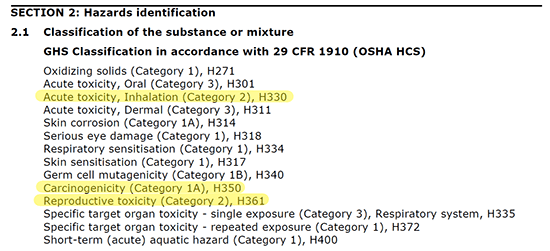Guidance for Creating Chemical SOPs
Identifying particularly hazardous substances
- Carcinogenicity (Category 1A) (Category 1B) (Category 2)
- Reproductive Toxicity (Category 1A) (Category 1B) (Category 2)
- Reproductive Toxicity (Effects on or via lactation)
- Acute toxicity, oral (Category 1) (Category 2)
- Not required for categories 3 and 4
- Acute toxicity, dermal (Category 1) (Category 2)
- Not required for categories 3 and 4
- Acute toxicity, inhalation (Category 1) (Category 2)
- Not required for categories 3 and 4
Example: Hazard identification for the chemical chromium(VI) oxide is shown below. Chromium(VI) oxide is a Particularly Hazardous Substance due to the Carcinogenicity (Category 1A), Reproductive toxicity (Category 2), and Acute Toxicity, Inhalation (Category 2) hazard classifications.

Establishing safe work practices for particularly hazardous substances
- The establishment of a designated area or areas that indicate the physical limits of exposure to particularly hazardous substances.
- The use of containment devices, such as laboratory-type hoods or glove boxes.
- Procedures for the safe removal of contaminated waste.
- Decontamination procedures.
Developing and writing Standard Operating Procedures
Referencing information sources, including the CMU Chemical Hygiene Plan, Safety Data Sheets, and chemical safety literature, is highly recommended when creating SOPs for your lab. However, it is crucial to consider the information in the SOPs must be detailed and directly applicable to your laboratory. General descriptions of safe work practices or references to regulations or literature are not satisfactory. Furthermore, some information found in safety data sheets may be accurate, but ultimately not useful for lab employees. For example, some safety data sheets will advise use of respirators or breathing apparatus to prevent inhalation exposure. In practice, the vast majority of labs at CMU utilize fume hoods or glove boxes in place of respirators. If your lab does not utilize respirators, it would be inappropriate to prescribe use of respirators in an SOP for your lab.
NOTE: Everyone working in a lab/shop/studio that contains particularly hazardous substances (whether the individual uses the chemical or not) must review the SOP and know how to respond in an emergency.